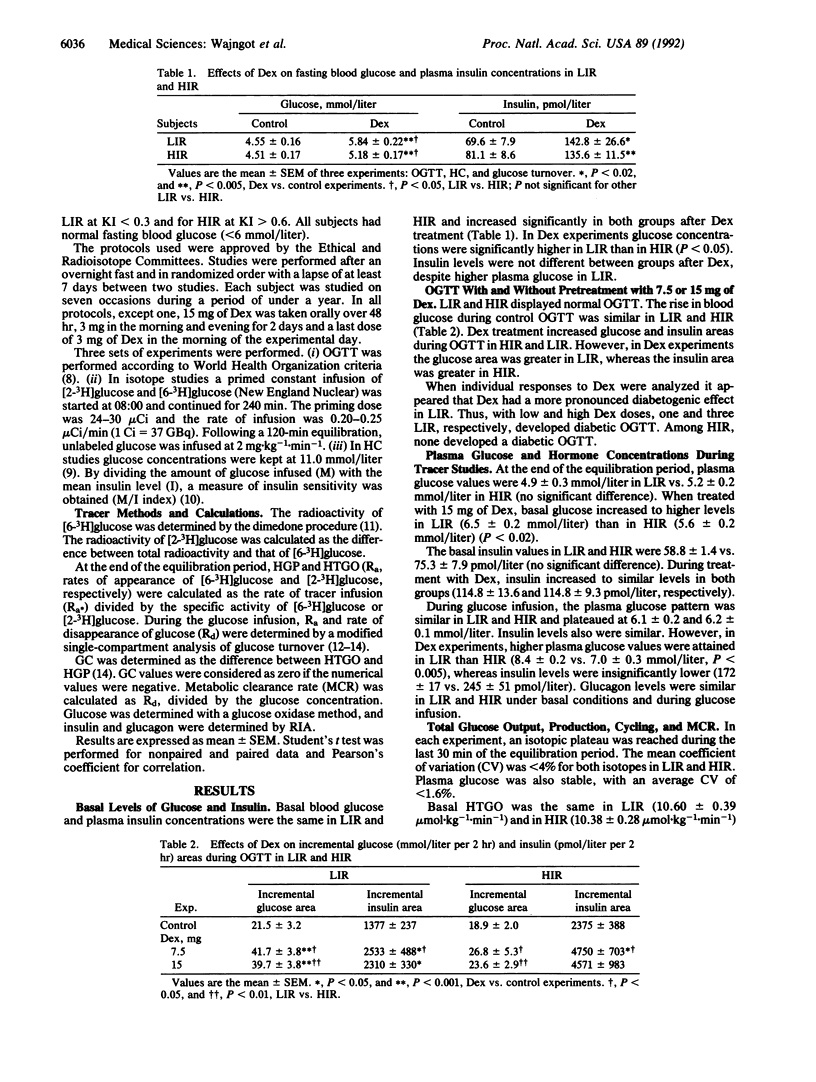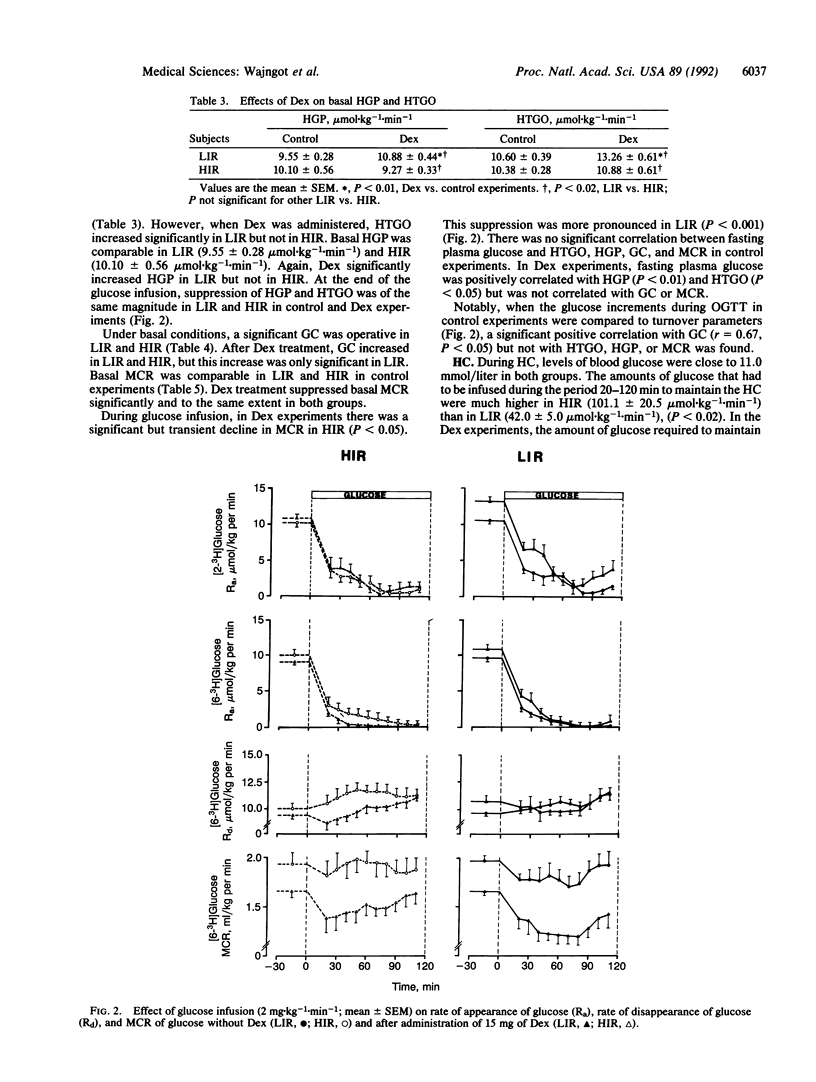Abstract
We investigated in six low- and six high-insulin responders (LIR and HIR) the effect of dexamethasone (Dex, 15 mg orally during 48 hr) on oral glucose tolerance (OGTT), glucose turnover under basal conditions and during glucose infusion of 2 mg.kg-1.min-1, and insulin response during hyperglycemic clamp. Dex increased fasting glucose more in LIR (P less than 0.05). During OGTT, Dex caused a more prominent increment in glucose in LIR, whereas the increment in insulin was less in LIR (P less than 0.05). After Dex, in three LIR but in no HIR, a diabetic OGTT was observed. Dex significantly increased basal hepatic glucose production (turnover measured with [6-3H]glucose), hepatic total glucose output (turnover measured with [2-3H]glucose), and glucose cycling (hepatic total glucose output--hepatic glucose production) only in LIR. Dex decreased basal glucose metabolic clearance to the same extent in LIR and HIR. Hyperglycemic clamp revealed that Dex induced a significant increase (P less than 0.05) in insulin response only in HIR. Dex effects on insulin release during hyperglycemic clamp were negatively correlated with the glucose area during Dex OGTT (P less than 0.01). Thus, the double tracer method provided a new insight into the pathogenesis of the steroid effect on carbohydrate tolerance. Dex increased basal glycemia more in LIR because only in LIR was glucose production increased. During OGTT, the LIR who were not able to counteract the effects of Dex by an appropriate enhancement in insulin secretion developed a decreased OGTT. The evaluation of insulin response after Dex may thus allow differentiation of the subset of LIR that run an increased risk of non-insulin-dependent diabetes mellitus.
Full text
PDF




Images in this article
Selected References
These references are in PubMed. This may not be the complete list of references from this article.
- Cerasi E., Luft R. The plasma insulin response to glucose infusion in healthy subjects and in diabetes mellitus. Acta Endocrinol (Copenh) 1967 Jun;55(2):278–304. doi: 10.1530/acta.0.0550278. [DOI] [PubMed] [Google Scholar]
- DEBODO R. C., STEELE R., ALTSZULER N., DUNN A., BISHOP J. S. ON THE HORMONAL REGULATION OF CARBOHYDRATE METABOLISM; STUDIES WITH C14 GLUCOSE. Recent Prog Horm Res. 1963;19:445–488. [PubMed] [Google Scholar]
- DUNN D. F., FRIEDMANN B., MAASS A. R., REICHARD G. A., WEINHOUSE S. Effects of insulin on blood glucose entry and removal rates in normal dogs. J Biol Chem. 1957 Mar;225(1):225–237. [PubMed] [Google Scholar]
- DeFronzo R. A., Tobin J. D., Andres R. Glucose clamp technique: a method for quantifying insulin secretion and resistance. Am J Physiol. 1979 Sep;237(3):E214–E223. doi: 10.1152/ajpendo.1979.237.3.E214. [DOI] [PubMed] [Google Scholar]
- DeFronzo R. A., Tobin J. D., Rowe J. W., Andres R. Glucose intolerance in uremia. Quantification of pancreatic beta cell sensitivity to glucose and tissue sensitivity to insulin. J Clin Invest. 1978 Aug;62(2):425–435. doi: 10.1172/JCI109144. [DOI] [PMC free article] [PubMed] [Google Scholar]
- Efendić S., Luft R., Wajngot A. Aspects of the pathogenesis of type 2 diabetes. Endocr Rev. 1984 Summer;5(3):395–410. doi: 10.1210/edrv-5-3-395. [DOI] [PubMed] [Google Scholar]
- Grill V., Pigon J., Hartling S. G., Binder C., Efendic S. Effects of dexamethasone on glucose-induced insulin and proinsulin release in low and high insulin responders. Metabolism. 1990 Mar;39(3):251–258. doi: 10.1016/0026-0495(90)90043-c. [DOI] [PubMed] [Google Scholar]
- Iselius L., Lindsten J., Morton N. E., Efendić S., Cerasi E., Haegermark A., Luft R. Genetic regulation of the kinetics of glucose-induced insulin release in man. Studies in families with diabetic and non-diabetic probands. Clin Genet. 1985 Jul;28(1):8–15. doi: 10.1111/j.1399-0004.1985.tb01210.x. [DOI] [PubMed] [Google Scholar]
- Kosaka K., Hagura R., Kuzuya T. Insulin responses in equivocal and definite diabetes, with special reference to subjects who had mild glucose intolerance but later developed definite diabetes. Diabetes. 1977 Oct;26(10):944–952. doi: 10.2337/diab.26.10.944. [DOI] [PubMed] [Google Scholar]
- McMahon M., Gerich J., Rizza R. Effects of glucocorticoids on carbohydrate metabolism. Diabetes Metab Rev. 1988 Feb;4(1):17–30. doi: 10.1002/dmr.5610040105. [DOI] [PubMed] [Google Scholar]
- Radziuk J., Norwich K. H., Vranic M. Experimental validation of measurements of glucose turnover in nonsteady state. Am J Physiol. 1978 Jan;234(1):E84–E93. doi: 10.1152/ajpendo.1978.234.1.E84. [DOI] [PubMed] [Google Scholar]
- Rull J. A., Conn J. W., Floyd J. C., Jr, Fajans S. S. Levels of plasma insulin during cortisone glucose tolerance tests in "nondiabetic" relatives of diabetic patients. Implications of diminished insulin secretory reserve in subclinical diabetes. Diabetes. 1970 Jan;19(1):1–10. doi: 10.2337/diab.19.1.1. [DOI] [PubMed] [Google Scholar]
- Speth M., Schulze H. U. Hormone-induced effects on the rat liver microsomal glucose-6-phosphatase system in vitro. Biochem Biophys Res Commun. 1981 Mar 16;99(1):134–141. doi: 10.1016/0006-291x(81)91723-x. [DOI] [PubMed] [Google Scholar]
- Wajngot A., Khan A., Giacca A., Vranic M., Efendic S. Dexamethasone increases glucose cycling, but not glucose production, in healthy subjects. Am J Physiol. 1990 Nov;259(5 Pt 1):E626–E632. doi: 10.1152/ajpendo.1990.259.5.E626. [DOI] [PubMed] [Google Scholar]
- Wajngot A., Luft R., Efendić S. Oral glucose tolerance test and insulin sensitivity in low insulin responders. Acta Endocrinol (Copenh) 1983 Sep;104(1):77–84. doi: 10.1530/acta.0.1040077. [DOI] [PubMed] [Google Scholar]



